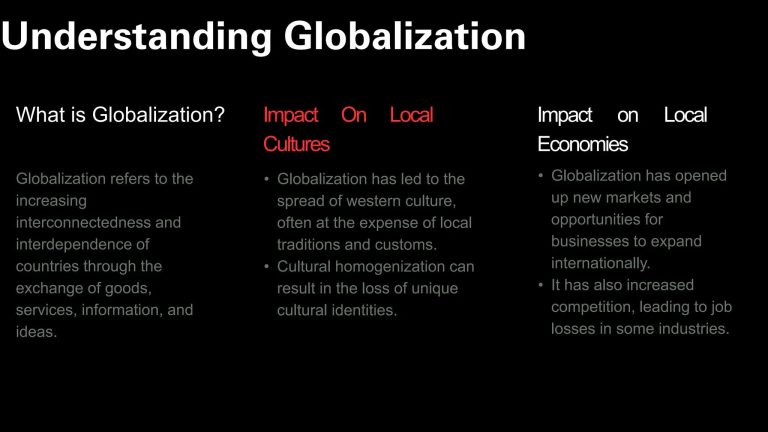Globalization is reaching deeper into daily life, reshaping local cultures and traditions from coastlines to inland villages. As trade, migration and digital platforms collapse distances, long-standing rituals are being adapted, repackaged or in some cases abandoned, while new hybrids emerge at the intersection of global markets and local identity.
Advocates say wider exposure brings fresh audiences, jobs and creative exchange; critics warn of homogenization, cultural loss and a narrowing of authenticity into what sells. The tension is visible in street food recipes altered for international palates, in folk festivals redesigned for tourism, and in languages and dress codes that shift with the rise of global media. Artisans are turning to e-commerce to survive, diaspora communities are exporting styles back home, and schools and policymakers are reviving indigenous practices even as foreign influences surge.
This article examines how communities navigate that push and pull-what is gained, what is at risk, and who decides-tracking the choices playing out on smartphone screens and in town squares, and the policies that aim to protect heritage without freezing it in time.
Table of Contents
- Globalization reshapes local cultures and traditions as streaming platforms and tourism standardize tastes and festival formats
- Language blending and artisanal decline accelerate in port cities and tech hubs while diaspora networks revive cuisines and rituals in new markets
- Policymakers should fund bilingual curricula and digital archives, offer tax incentives and export backing for artisans, and require cultural impact reviews for major tourism and retail projects
- In Summary
Globalization reshapes local cultures and traditions as streaming platforms and tourism standardize tastes and festival formats
Streaming catalogs and tourist itineraries are increasingly shaping local cultural calendars, with festival planners and heritage groups reporting pressure to favor exportable aesthetics and algorithm-friendly lineups; analysts say itineraries are being streamlined for predictability, multi-day rites compressed into highlight slots, and culinary offerings tweaked for viral appeal, creating an experience template that travels from coastal lantern nights to inland harvest fairs while narrowing regional distinctions; in response, city bureaus and community stewards are piloting measures to protect texture without sacrificing audience growth, testing policies that recalibrate what gets booked, branded, and broadcast.
- Programming: Quotas for regional acts and local-language hosts embedded alongside global headliners.
- Formats: Caps on stage redesigns and fixed time blocks to safeguard rites beyond photo moments.
- Sponsorship: Restrictions on uniform branding to prevent commercial overlays from eclipsing symbols.
- Foodways: Vendor charters that prioritize traditional methods while permitting limited fusion stalls.
- Rights: Revenue-sharing with custodial communities and IP labels for sacred or ceremonial motifs.
- Discovery: Platform agreements to elevate locality filters and editorial playlists beyond trending loops.
Language blending and artisanal decline accelerate in port cities and tech hubs while diaspora networks revive cuisines and rituals in new markets
Across crowded harbors and fast-growing innovation corridors, everyday speech is remixing as dock crews, traders, and software teams coin hybrid slang, even as small workshops shutter under rising rents and platform-driven retail. Guild representatives and city planners note that apprenticeships are thinning while just‑in‑time logistics reward speed over skill, yet parallel channels led by diaspora entrepreneurs are bringing heritage foods and ceremonial practices to new audiences through cloud kitchens, micro-festivals, and creator-led instruction. Analysts describe a split marketplace: street corners where three languages interleave into one, factory floors where CNC replaces chisels, and storefronts where fermented staples, harvest rites, and textile traditions return as limited releases, cross-border collaborations, and traveling residencies.
- Linguistic convergence: blended vernaculars normalize workplace code-switching and signage toggling between scripts, complicating education and public service delivery.
- Workshop attrition: legacy makers cite rent volatility, raw-material bottlenecks, and algorithmic pricing as pressures accelerating closures and consolidation.
- Diaspora-led revival: kin networks test regional menus, ritual calendars, and craft kits in new markets, seeding demand for training, transparent sourcing, and cultural stewardship.
Policymakers should fund bilingual curricula and digital archives, offer tax incentives and export backing for artisans, and require cultural impact reviews for major tourism and retail projects
Governments are moving to stabilize cultural ecosystems by pairing education and heritage tech with fiscal levers and planning oversight, aiming to keep local languages, crafts, and urban identities competitive amid global retail consolidation and platform tourism.
- Bilingual curricula and digital heritage: Mandate dual-language instruction in public schools, fund community-led digitization of archives, and deploy open-access platforms with local IP protections.
- Artisan tax incentives and export backing: Offer targeted tax credits for certified cultural producers, provide export insurance and trade-fair subsidies, and streamline customs codes for handcrafted goods.
- Cultural impact reviews for large projects: Require pre-approval assessments for mega-malls, resorts, and short-term rental expansions, with enforceable mitigation plans, community benefit agreements, and post-opening audits.
- Measurement and transparency: Publish annual indicators-language use in schools, craft-sector incomes, and heritage site footfall-with open data to course-correct funding.
- Equity safeguards: Prioritize Indigenous and minority communities through grant set‑asides, fair-pay standards, and local procurement targets.
In Summary
As cross-border trade, travel and technology tighten their grip, the collision between global markets and local identities is less a simple loss than a constant renegotiation. From cuisine and crafts to festivals and language, communities are adapting-commercializing some practices, protecting others, and inventing new hybrids that speak to both hometown and worldwide audiences.
What comes next will hinge on policy and platforms as much as on parades and prayer: education that sustains minority tongues, intellectual property rules that reward artisans, tourism strategies that don’t hollow out neighborhoods, and algorithms that surface more than the most clickable. For now, the balance remains unsettled. The reshaping of tradition is ongoing, traced in everyday choices about what to preserve, what to share and what to reinvent when the local meets the world.


